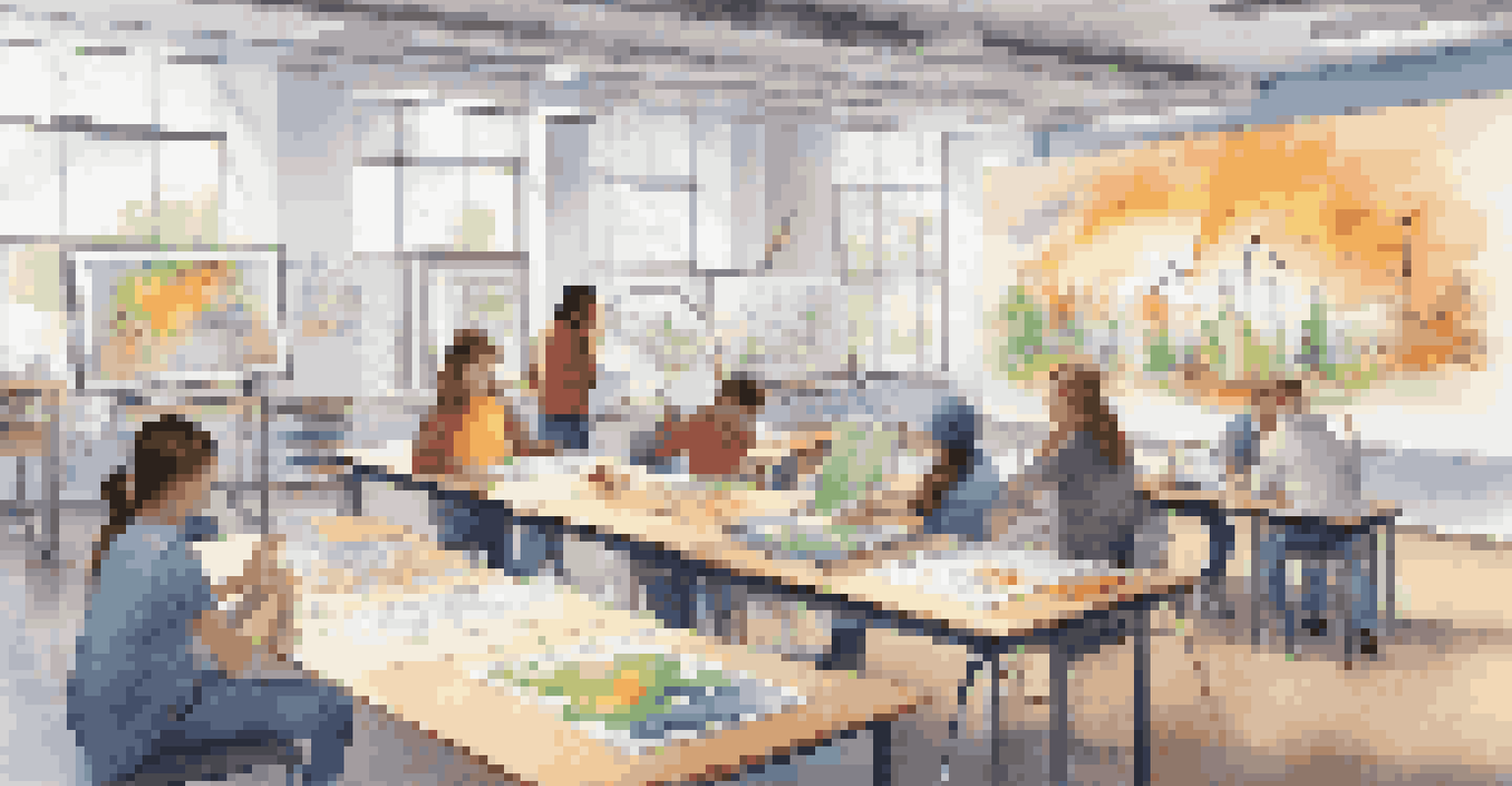Fostering Creativity in Students with Interdisciplinary Projects

Understanding Interdisciplinary Learning
Interdisciplinary learning merges different subjects to create a richer educational experience. Instead of viewing subjects in isolation, students see the connections between them, sparking creativity. For example, a project that combines science and art can inspire students to explore the scientific principles behind color mixing.
Education is not the filling of a pail, but the lighting of a fire.
This approach encourages students to think critically and creatively, as they must apply knowledge from various areas. When students understand how different disciplines interact, they are more likely to engage deeply with their learning. This holistic view fosters an environment ripe for innovation.
Moreover, interdisciplinary projects often mimic real-world scenarios, where problems aren't confined to a single area of expertise. By engaging in this type of learning, students develop skills that are essential for future careers, such as collaboration, problem-solving, and adaptability.
Benefits of Interdisciplinary Projects
Interdisciplinary projects come with a host of benefits that enhance student learning. They not only boost creativity but also improve critical thinking skills, as students learn to approach problems from multiple angles. For instance, a project on climate change might integrate geography, science, and ethics, prompting students to consider various perspectives.

Additionally, these projects cultivate a sense of ownership and personal investment in the learning process. When students are allowed to explore topics that interest them across different subjects, they are more likely to engage deeply with the material. This engagement leads to better retention of information and a love for learning.
Interdisciplinary Learning Sparks Creativity
By merging subjects, students discover connections that inspire innovative thinking and deepen engagement.
Finally, interdisciplinary projects prepare students for collaboration in diverse teams, an essential skill in today's interconnected world. By learning to communicate and work with peers from various backgrounds and disciplines, students become more versatile and confident individuals.
Creating Engaging Interdisciplinary Projects
To foster creativity, teachers should design projects that are engaging and relevant to students' lives. This can begin with brainstorming sessions where students suggest topics that interest them. For example, a project on renewable energy could lead to discussions in science, economics, and even art, as students create visual representations of their ideas.
The greatest innovations are often the result of interdisciplinary collaboration.
Moreover, incorporating technology can enhance these projects significantly. Tools like digital presentations, video editing software, and online collaboration platforms allow students to express their creativity in diverse ways. When students leverage technology, they can produce innovative projects that reflect their unique perspectives.
It's also beneficial to include real-world applications in project design. Collaborating with local businesses or community organizations can provide students with valuable insights and feedback, further enriching their experience. This connection to the community not only deepens learning but also instills a sense of responsibility and purpose.
Encouraging Collaboration Among Students
Collaboration is a key component of interdisciplinary projects, enabling students to learn from one another. Working in teams encourages individuals to share ideas and perspectives, fostering a culture of creativity. For instance, a diverse group of students might bring unique insights to a project on cultural influences in art, leading to richer discussions and outcomes.
Establishing clear roles within teams can also enhance collaboration. When students understand their responsibilities, they are more likely to contribute effectively. For example, one student might focus on research while another handles the presentation, allowing them to leverage their strengths and support each other.
Collaboration Enhances Learning Outcomes
Working in diverse teams encourages idea sharing, leading to richer discussions and improved project quality.
Furthermore, providing opportunities for peer feedback can improve the quality of the projects. When students present their work to one another, they receive valuable critiques that can spark new ideas and improvements. This iterative process not only enhances the final product but also nurtures a supportive learning community.
Integrating Technology in Projects
In today's digital age, technology plays a pivotal role in enhancing interdisciplinary projects. Utilizing tools like virtual reality, coding, and multimedia resources can make learning more interactive and engaging. For example, students might create a virtual tour of historical sites while integrating geography and history lessons.
Moreover, technology allows for the collection and analysis of data, which is essential in many interdisciplinary projects. Students can conduct surveys, analyze results, and present their findings in creative formats. This hands-on approach not only fosters creativity but also builds analytical skills that are valuable in any field.
Finally, online platforms facilitate collaboration beyond the classroom. Students can connect with experts, access a wealth of resources, and showcase their projects to a broader audience. This exposure not only validates their efforts but also encourages them to think outside the box and push their creative boundaries.
Assessment in Interdisciplinary Learning
Assessing interdisciplinary projects can be challenging, but it’s crucial for understanding student learning. Traditional tests may not capture the creativity and critical thinking involved in these projects. Instead, educators can use rubrics that consider collaboration, innovation, and the application of knowledge across subjects.
Self-assessment and peer evaluations also play a vital role in assessing student learning. Encouraging students to reflect on their contributions and the group dynamics helps them develop a deeper understanding of their learning process. This reflective practice not only enhances their metacognitive skills but also promotes a growth mindset.
Technology Boosts Project Engagement
Utilizing modern tools makes learning interactive, allowing students to express creativity and analyze data effectively.
Moreover, showcasing student work to a larger audience can serve as a form of assessment. Presentations, exhibitions, or even digital portfolios allow students to demonstrate their learning in creative ways. This not only provides valuable feedback but also fosters a sense of pride and accomplishment in their work.
Fostering a Creative Classroom Environment
To truly foster creativity, educators must create a classroom environment that encourages exploration and innovation. This involves promoting a culture where mistakes are seen as learning opportunities rather than failures. For instance, sharing stories of famous inventors and their setbacks can inspire students to take risks in their own projects.
Additionally, providing a flexible and resource-rich environment can spark creativity. Classrooms equipped with various materials and technology promote hands-on learning and experimentation. When students have the freedom to explore and create, they are more likely to generate unique ideas.

Lastly, fostering relationships between students and teachers can enhance creativity. When students feel supported and valued, they are more likely to express their ideas openly. A classroom that prioritizes emotional safety encourages students to share their thoughts and collaborate more freely, leading to a richer learning experience.